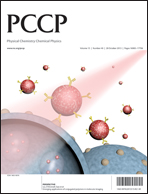Effect of the acceptor on the performance of dye-sensitized solar cells†
Abstract
Three new phenothiazine dyes were designed and synthesized, utilizing different acceptor groups. Upon application to TiO2-based solar cells, the effects of different acceptors on the photophysical and electrochemical properties of the dyes and the solar cell performance are detailed. The introduction of a pyridinium unit or 5-carboxy-1-hexyl-2,3,3-trimethyl-indolium unit into the molecular frame as the acceptor instead of cyano acrylic acid can effectively cause a red shift in the absorption spectra. Applied to DSSCs, the devices sensitized by CM502 with the pyridinium unit as the acceptor show the highest efficiency of 7.3%. The devices fabricated with dye CM501 with cyano acrylic acid as the acceptor exhibited the highest Voc while for the devices sensitized by the dye CM503 with 5-carboxy-1-hexyl-2,3,3-trimethyl-3H-indolium unit as the acceptor, the Voc value was the lowest, at 494 mV. The addition of TBP in the electrolyte can improve the performance of DSSCs fabricated using CM501 and CM502, with the Voc value greatly improved but the Jsc value slightly decreased. However, with the addition of TBP in the electrolyte, the efficiency of the cells sensitized by CM503 dropped significantly (from 4.9% to 1.0% when 0.1 M TBP was added).


 Please wait while we load your content...
Please wait while we load your content...